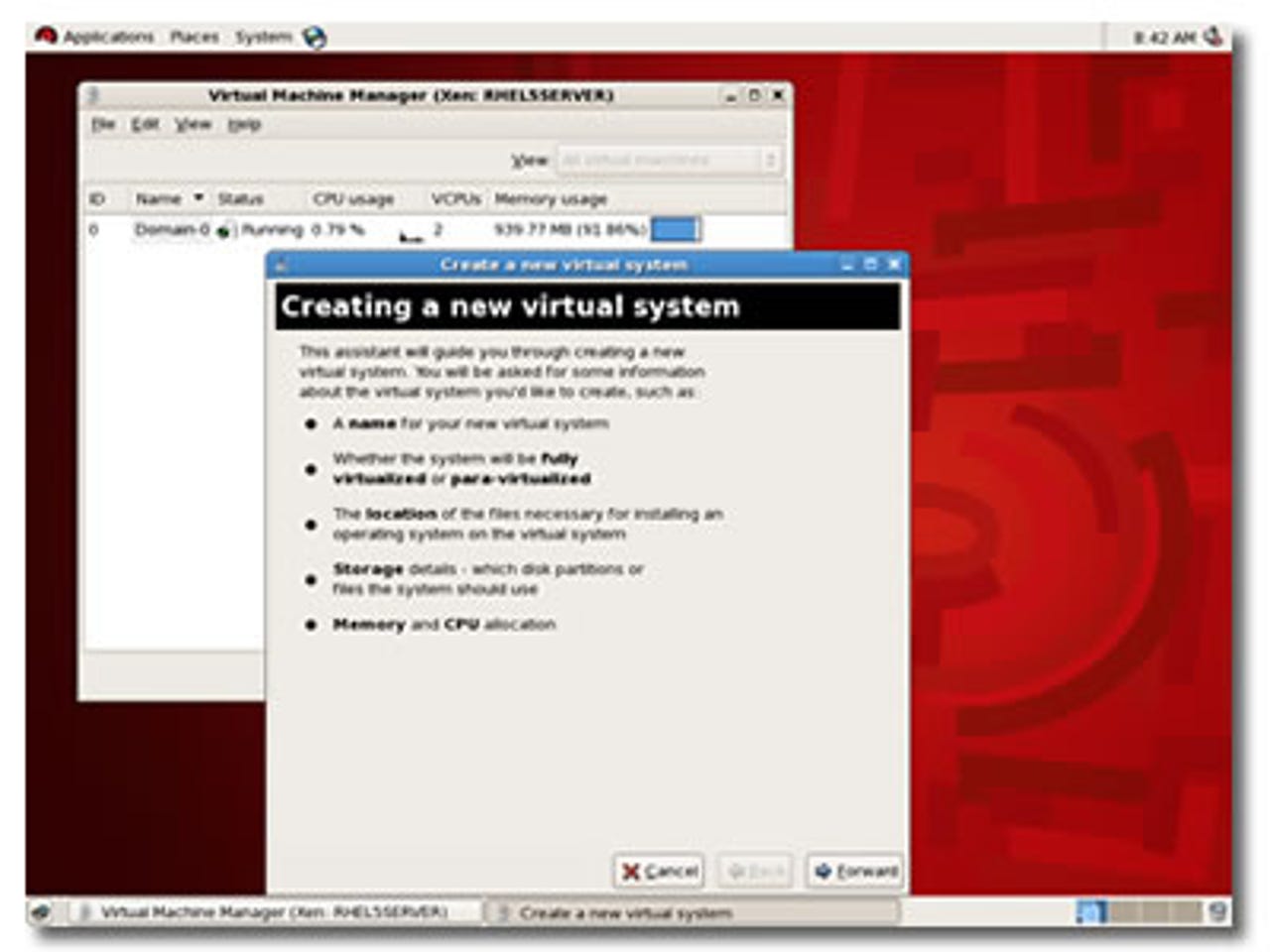Red Hat Enterprise Linux 5


Some two years in development, the latest version of Red Hat’s Enterprise Linux platform, RHEL 5, was finally launched on 14 March 2007. The open source performance, functionality and security updates are all present and correct, but of greatest significance is the newly integrated Xen virtualisation technology — marketed for the first time as suitable for production use — together with a complete revamp of the way the product is licensed.
Virtualisation, virtualisation, virtualisation
The much-heralded virtualisation features are based on XenSource technology, which in RHEL 5 provides support for both 'para-virtualisation' — where guests are limited to modified Linux implementations (either RHEL 4.5 or 5) — and the ability to run a guest operating system, such as Windows, unmodified. However, you will need a server with the latest Intel VT- or AMD-V-enabled processors to take advantage of the latter full virtualisation option.
Command-line and graphical management tools are included with the XenSource software, although these aren’t as well integrated as on rival Linux implementations, such as Novell’s SLES 10, and nowhere near as comprehensive or as easy to use as those from Microsoft or market leader VMWare. Bear in mind, too, that Red Hat doesn’t currently offer support for Windows guests running on its platform, although it has indicated that it may do so before long.
New licensing
The new licensing scheme takes a little understanding. An annual subscription model still applies, entitling customers to updates and support for the Red Hat software while at the same time specifying the functionality on offer. The old ES and AS server subscriptions are gone, to be replaced by a single RHEL 5 server that can be implemented on a wide range of processors, including both 32-bit and 64-bit Intel/AMD chips plus Intel’s Itanium 2 platform, IBM POWER and zSeries mainframes.
Performance is much enhanced in this release, especially on multi-core platforms with support for the latest quad-core implementations and improved SMP scalability. However, in our tests RHEL 5 didn’t prove significantly faster than other enterprise Linux implementations running on the same hardware.
On the plus side, a major benefit of the new subscription model is the use of the same base Linux package regardless of the platform or licence involved. So even on an entry-level server you get everything on offer, including the full complement of virtualisation features.
There are still limitations when it comes to the number of processors that can be supported. As with the old ES product, just two sockets are allowed in the base RHEL 5 server package. You’re also limited to just four virtual guests unless you opt for a subscription to the new Red Hat Advanced Platform, which has no limits when it comes to either processors or VM guests.
On the face of it, the Advanced Platform looks like a direct replacement for the old AS package. However, that isn’t quite the case: in addition to the base Linux distro, the Advanced Platform includes an implementation of the Red Hat Cluster Suite and the vendor’s storage virtualisation product, Red Hat Global File system, enabling virtual machines to failover or be migrated from one host to another without having to move the associated storage.
Other enhancements
At the launch, Red Hat was keen to champion the advantages of its particular brand of virtualisation. The combination of the revamped licensing model and Advanced Platform tools will help customers make much larger savings when consolidating servers compared to rival virtualisation products, the company claims.
That is debatable, but for companies where virtualisation isn’t such a big issue there are lots of other new features and enhancements that are likely to prove equally compelling.
The desktop implementations, for example, have also been rationalised, with the previously separate Red Hat Desktop and dual processor WS (Workstation) licenses replaced by a single RHEL Desktop. Unfortunately two new optional enhancements have then been added, one of which (the Workstation option) effectively recreates the old WS product by adding dual socket and unlimited memory support. The other, an all-new Multi-OS option, adds similar virtualisation facilities to those provided on the server (not included as standard on the desktop version), with support for up to four virtual guests when this option is applied.
Security is also enhanced across the complete RHEL 5 family, with improvements to both the SELinux implementation and management tools, plus auditing updates to help meet compliance requirements. There’s better support for IPv6 and improved integration with Active Directory for Samba, while desktop users will welcome support for high-performance graphics cards, better wireless and power management facilities plus printer and USB enhancements. The application bundle includes updated versions of Firefox and OpenOffice, while the GNOME desktop is little altered apart from the ability to add fancy graphical effects (like those available with some other Linux desktops and Windows Vista) where AIGLX acceleration hardware/software is available.
Finally, installation has been streamlined with the option of supplying an installation number, included with each subscription, to automatically configure the setup to match the licence purchased. Minimal operator input is required as a result, and there's only one media set no matter what the ultimate implementation.
A long overdue update, RHEL 5 will help Red Hat counter competition from both Microsoft and Linux rivals, the virtualisation features alone making it well worth the wait. Another advantage is the ability for customers to upgrade straight away, with those running ES server able to download the base RHEL5 product immediately while those with AS will be able to get the full Advanced Platform features when they renew their subscriptions.
Subscription prices for all products are unaltered. Annual subscriptions start at €62 (~£42) for RHEL 5 Desktop, €287 (~£194) for RHEL 5 server and €1,235 (~£835) for the Red Hat Advanced Platform — all per system (ex. VAT).